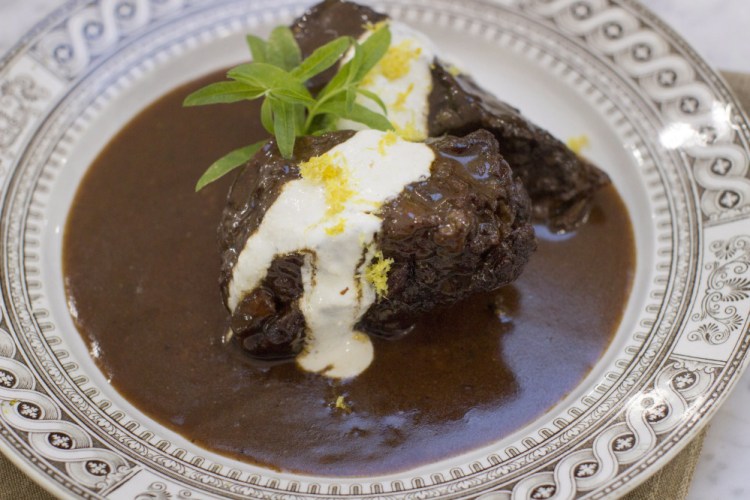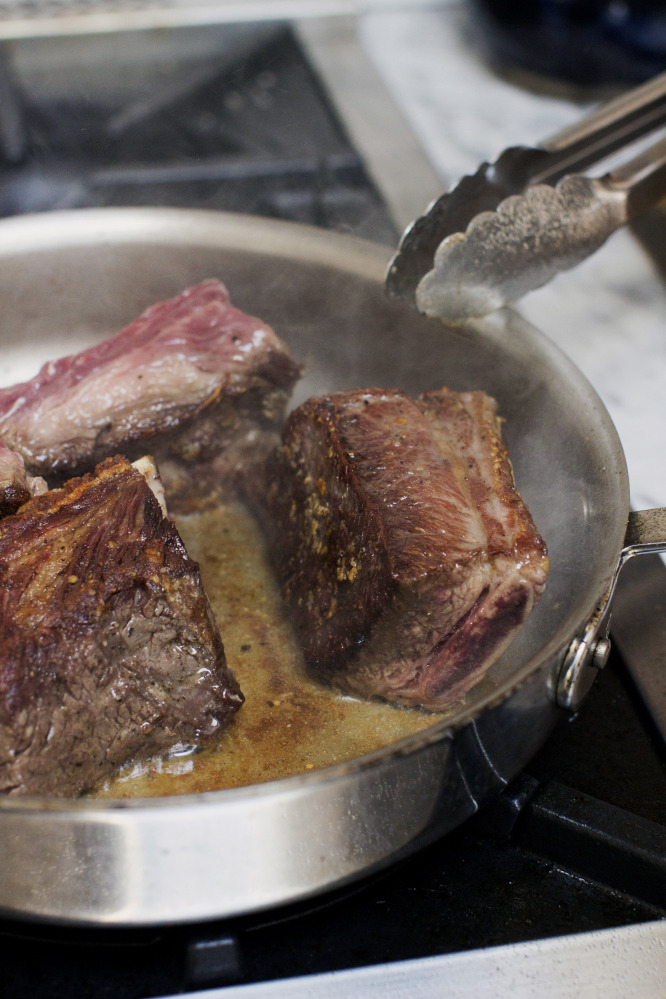Many people love the idea of a slow cooker because it seems so simple – open the pot, insert ingredients, cover the pot, turn on the heat, then leave it alone. Eight hours later, after a hard day at the office or chasing the kids, you uncover the pot and spoon out a perfectly cooked, and perfectly delicious, dinner. It’s a miracle.
And indeed that’s exactly the way it works with some slow cooker dishes, such as poule au pot (braised whole chicken with vegetables) or bean soups. But if it’s a deeply flavored meat dish, you’ll have to spend as much time prepping it as you would if you were cooking it on top of the stove or in the oven. There’s just no way to brown your meat or vegetables within the moist confines of a slow cooker, which means that those ingredients will require some time in the skillet beforehand.
Searing meat in a small amount of hot oil creates what’s known as the Maillard reaction – the meat turns a pleasing brown color and tastes that much better in the finished dish. The same is true for the low and slow browning of onions; the process not only tenderizes the onions, it deepens their color and concentrates their flavor. (Think French onion soup).
In this recipe, the garlic and tomato paste also benefit from a little time in the skillet before joining their confederates in the slow cooker.
After sauteing all of these items and transferring them to the cooker, there will be some brown bits left in the bottom of the skillet. These are concentrated meat and onion juices that you’d be crazy not to take advantage of. So the next step is to deglaze the pan, meaning to pour some liquid into it and scrape up those tasty little bits so that they’ll dissolve. In this case I used red wine – red wine and beef are a match made in heaven – but any liquid will do the trick.
I turned up the heat to simmer and reduce some of the wine, which tamps down its alcoholic edge and concentrates its flavor. Then I added just a few cups of chicken broth. Admittedly, this doesn’t seem like much liquid for all those short ribs. But one of the advantages of a slow cooker – compared to a Dutch oven or any kind of similar pot in which you’d braise something in an oven – is that none of the liquid escapes or evaporates. On the contrary, any of the liquid produced as the ingredients cook is going to accumulate in the pot. That’s why, when using a slow cooker, you want to cut in half the amount of liquid you add to an oven-braised or stew recipe. Otherwise, you’ll end up with a bland and watery sauce.
At this point, you might be wondering why anyone would bother to make short ribs with a slow cooker if it requires as much hands-on effort as braising them in an oven. It’s because nothing beats the low and steady temp of a slow cooker when it comes to producing the tastiest and most tender short ribs you’ve ever eaten.
RED WINE-BRAISED SLOW COOKER SHORT RIBS
This recipe tastes even better a few days after you make it. And if you make it ahead, it is easier to remove the fat. Here is what you do: After the ribs are tender, transfer them to a bowl and strain the cooking liquid over them, discarding the vegetables. Let the mixture cool, then cover and chill overnight. The fat will solidify on top and be very easy to scrape off and discard.
Then you just gently reheat the ribs and the liquid in a large saucepan until the ribs are warm. Strain the liquid and set it aside. Discard the bones and trim the excess fat and gristle from the ribs. Thicken the liquid following the instructions in the recipe, then add the ribs to the thickened liquid, heat and serve.
Start to finish: 4 to 5 or 9 to 10 hours, depending on slow cooker setting (1 hour active)
Servings: 8
5 pounds English-cut beef short ribs (bone-in), divided
Salt and ground black pepper
3 tablespoons extra-virgin olive oil, divided
1 1/2 cups thinly sliced yellow onion
2 medium carrots, medium chopped
1 tablespoon minced garlic
2 tablespoons tomato paste
1 sprig fresh thyme (or 1 teaspoon dried thyme)
1 bay leaf
750-milliliter bottle red wine
2 cups low-sodium chicken broth
5 tablespoons all-purpose flour
1/3 cup water
2 tablespoons Dijon mustard
1 tablespoon lemon juice
Horseradish sauce (recipe below)
Season the ribs with salt and pepper.
In a large skillet over high, heat half of the oil. Add half the ribs, reduce the heat to medium-high and cook until the ribs are browned on all sides, about 3 minutes per side. Transfer the ribs and most of the oil to a 5- to 7-quart slow cooker. Repeat with the remaining ribs and oil. Transfer the second batch of ribs to the slow cooker, but leave about 2 tablespoons of the oil in the skillet.
Reduce the heat under the skillet to medium-low and add the onion and carrots. Cook, stirring occasionally, until golden brown, 20 to 25 minutes. Add the garlic and cook for 1 minute. Add the tomato paste, thyme and bay leaf and saute for 2 minutes. Transfer the vegetable mixture to the slow cooker.
Return the skillet to medium heat and add the wine. Bring the wine to a boil and simmer until it is reduced to about 1 cup. Transfer to the slow cooker, then add the broth. Cover the slow cooker and cook on low for 9 to 10 hours, or on high for 4 to 5 hours, or until the meat is very tender and falling off the bone.
Use tongs to transfer the ribs to a platter and let stand until they are cool enough to be handled.
Meanwhile, strain the liquid in the slow cooker through a mesh strainer into a large saucepan, discarding the solids. Skim off any fat that floats to the surface, then bring to a boil over medium-high heat.
Whisk together the flour and water. In a steady stream while whisking, add half of the flour mixture to the cooking liquid. Bring the sauce to a boil and whisk in more of the flour mixture, if necessary, to achieve the desired consistency. The sauce should be thick, but still easily poured. Simmer for 5 minutes. Whisk in the mustard and lemon juice, then season with salt and pepper.
Meanwhile, discard the bones and trim any excess fat and gristle from the rib meat. Add the ribs to the saucepan and cook gently just until heated through. To serve, arrange rib meat on each plate and spoon some of the pan sauce over and top with some of the horseradish sauce.
Nutrition information per serving: 790 calories; 460 calories from fat (58 percent of total calories); 51 g fat (23 g saturated; 0 g trans fats); 230 mg cholesterol; 13 g carbohydrate; 2 g fiber; 4 g sugar; 52 g protein; 640 mg sodium.
HORSERADISH SAUCE
Start to finish: 5 minutes
Makes 1/2 cup
2 tablespoons bottled horseradish
6 tablespoons sour cream
1/4 teaspoon grated lemon zest
Kosher salt and ground black pepper
In a small bowl, whisk together the horseradish, sour cream and lemon zest. Season with salt and pepper.
Nutrition information per tablespoon: 25 calories; 15 calories from fat (60 percent of total calories); 2 g fat (1.5 g saturated; 0 g trans fats); 10 mg cholesterol; 1 g carbohydrate; 0 g fiber; 1 g sugar; 0 g protein; 75 mg sodium.
Send questions/comments to the editors.




